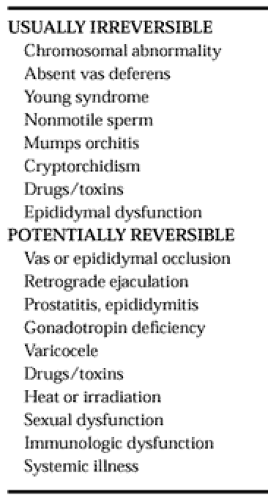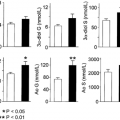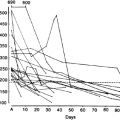MANAGEMENT OF MALE INFERTILITY
Part of “CHAPTER 118 – MALE INFERTILITY“
The primary management decision is whether there is an identifiable and treatable cause for the infertility. The causes of testicular dysfunction are listed in Table 118-6.
The failure to identify a known factor leads to the unsatisfying diagnosis of idiopathic infertility. This category probably
includes various factors, not yet identified, that produce a similar clinical picture of low sperm count, poor sperm motility, and infertility.
includes various factors, not yet identified, that produce a similar clinical picture of low sperm count, poor sperm motility, and infertility.
Numerous agents have been proposed for the treatment of idiopathic infertility. An evaluation of their efficacy is difficult because of the scarcity of well-conducted therapeutic trials that exclude spousal factors and improper coital techniques and include adequate basal evaluation with three to six semen samples collected during the 4 to 6 months before therapy, plus an adequate number of semen samples during and after therapy to document any effect. The treatment period should be at least 3 months to span one germ-cell cycle. Moreover, a double-blind placebo control is necessary because spontaneous pregnancies may occur that are unrelated to treatment.80 A review using metaanalyses of randomized controlled trials concluded that there is no demonstrable efficacy of medical treatments for idiopathic male infertility.81
Despite controversial efficacy, three hormonal approaches to therapy are often empirically employed: exogenous gonadotropins, antiestrogens, and aromatase inhibitors, which reduce conversion of androgens to estrogens.82,83,84,85,86,87 and 87a Gonadotropins have been used to provide an additional stimulus to the germinal epithelium and Leydig cells by increasing intratesticular testosterone with hCG or by stimulating germ-cell maturation with hMG or rFSH. Some studies indicate a positive response to exogenous gonadotropins, but this has not been confirmed in several carefully studied series.82,83 Clomiphene is an antiestrogen that increases gonadotropin release. Controlled studies with clomiphene at a dosage between 25 and 50 mg per day for 3 to 6 months have reported both negative and positive responses, and the present data must be regarded as discouraging.84,85 An aromatase inhibitor, testolactone, has been used, based on the possibility that excess estrogen may impair the germinal epithelium. An initial study without a control group reported success, but a subsequent study with placebo controls and patient crossover showed no effect on sperm count or fertility.86,87 Random, sustained increases in sperm count occur during both placebo and drug therapy (Fig. 118-3), illustrating the importance of controls in therapeutic trials.
Stay updated, free articles. Join our Telegram channel

Full access? Get Clinical Tree






